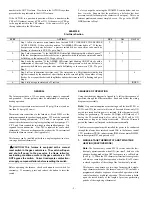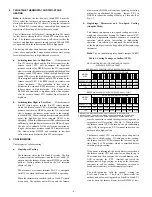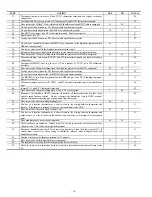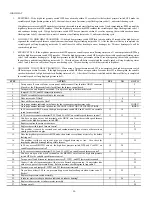
- 5 -
cooling airflow which is the true on-board CF selection as
shown in Table 1.
If the furnace control CPU switches from low-cooling to
high-cooling, the furnace control CPU will energize the air
conditioning relay ACR. When the air conditioning relay
ACR is energized the R to Y1-and-Y2 circuits switch the
outdoor unit to high-cooling speed, and the R to G-and-
Y1-and-Y/Y2 circuits transition the furnace blower motor
BLWM to high-cooling airflow. High-cooling airflow is
based on the A/C selection shown in Table 1.
Note:
When transitioning from low-cooling to high-
cooling the outdoor unit compressor will shut down for 1
minute while the furnace blower motor BLWM transitions
to run at high-cooling airflow.
The electronic air cleaner terminal EAC-1 is energized
with 115 vac whenever the blower motor BLWM is
operating.
When the thermostat is satisfied, the R to G-and-Y circuit
are opened. The outdoor unit stops, and the furnace
blower BLWM and electronic air cleaner terminal EAC-1
will remain energized for an additional 90 seconds.
Jumper Y1 to DHUM to reduce the cooling off-delay to 5
seconds. (See Fig. 1.)
c. Two-Stage Thermostat and Two-Speed Cooling
Note:
The air conditioning relay disable jumper ACRDJ
must be disconnected to allow thermostat control of the
outdoor unit staging. (See Fig. 1.)
The thermostat closes the R to G-and-Y1 circuits for low-
cooling or closes the R to G-and-Y1-and-Y2 circuits for
high-cooling. The R to Y1 circuit starts the outdoor unit
on low-cooling speed, and the R to G-and-Y1 circuit starts
the furnace blower motor BLWM at low-cooling airflow
which is the true on-board CF selection as shown in Table
1. The R to Y1-and-Y2 circuits start the outdoor unit on
high-cooling speed, and the R to G-and-Y/Y2 circuits start
the furnace blower motor BLWM at high-cooling airflow.
High-cooling airflow is based on the A/C selection shown
in Table 1.
The electronic air cleaner terminal EAC-1 is energized
with 115 vac whenever the blower motor BLWM is
operating.
When the thermostat is satisfied, the R to G-and-Y1 or
R to G-and-Y1-and-Y2 circuits are opened. The outdoor
unit stops, and the furnace blower BLWM and electronic
air cleaner terminal EAC-1 will remain energized for an
additional 90 seconds. Jumper Y1 to DHUM to reduce the
cooling off-delay to 5 seconds. (See Fig. 1.)
4. THERMIDISTAT
MODE
The dehumidification output, DHUM on the Thermidistat
should be connected to the furnace control thermostat terminal
DHUM. When there is a dehumidify demand, the DHUM input
is activated, which means 24 vac signal is removed from the
DHUM input terminal. In other words, the DHUM input logic
is reversed. The DHUM input is turned ON when no
dehumidify demand exists. Once 24 vac is detected by the
furnace control on the DHUM input, the furnace control
operates in Thermidistat mode. If the DHUM input is low for
more than 48 hours, the furnace control reverts back to non-
Thermidistat mode.
The cooling operation described in item 3. above also applies to
operation with a Thermidistat. The exceptions are listed below:
a.
When the R to G-and-Y1 circuit is closed and there is a
demand for dehumidification, the furnace blower motor
BLWM will drop the blower airflow to 86% of low-cooling
airflow which is the true on-board CF selection as shown in
Table 1.
b.
When the R to G-and Y/Y2 circuit is closed and there is a
demand for dehumidification, the furnace blower motor
BLWM will drop the blower airflow to 86% of high-
cooling airflow. High-cooling airflow is based on the A/C
selection shown in Table 1.
c.
When the “call for cooling” is satisfied and there is a
demand for dehumidification, the cooling blower-off delay
is decreased from 90 seconds to 5 seconds.
5. SUPER-DEHUMIDIFY
MODE
Super-Dehumidify mode can only be entered if the furnace
control is in the Thermidistat mode and there is a demand for
dehumidification. The cooling operation described in item 3.
above also applies to operation with a Thermidistat. The
exceptions are listed below:
a.
When the R to Y1 circuit is closed, R to G circuit is open,
and there is a demand for dehumidification, the furnace
blower motor BLWM will drop the blower airflow to 65%
of low-cooling airflow for a maximum of 10 minutes each
cooling cycle or until the R to G circuit closes or the
demand for dehumidification is satisfied. Low-cooling
airflow is the true on-board CF selection as shown in Table
1.
b.
When the R to Y/Y2 circuit is closed, R to G circuit is open,
and there is a demand for dehumidification, the furnace
blower motor BLWM will drop the blower airflow to 65%
of high-cooling airflow for a maximum of 10 minutes each
cooling cycle or until the R to G circuit closes or the
demand for dehumidification is satisfied. High-cooling
airflow is based on the A/C selection shown in Table 1.
c.
When the “call for cooling” is satisfied and there is a
demand for dehumidification, the cooling blower-off delay
is decreased from 90 seconds to 5 seconds.
6. Continuous Blower Mode
When the R to G circuit is closed by the thermostat, the blower
motor BLWM will operate at continuous blower airflow.
Continuous blower airflow selection is initially based on the CF
selection shown in Table 1. Factory default is shown in Table
1. Terminal EAC-1 is energized as long as the blower motor
BLWM is energized.
During a call for heat, the furnace control CPU will transition
the blower motor BLWM to continuous blower airflow, low-
heat airflow, or the midrange airflow, whichever is lowest. The





































